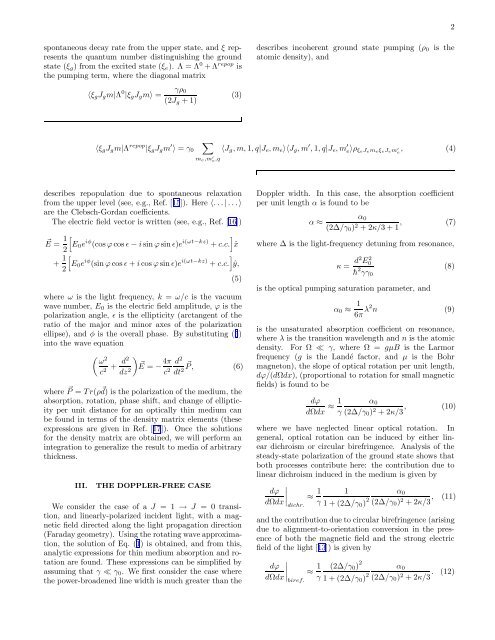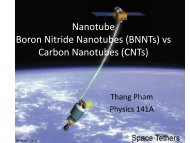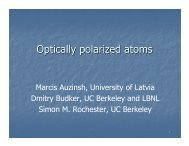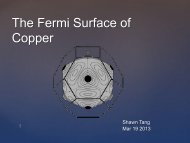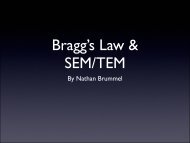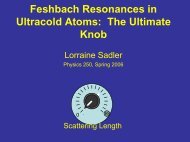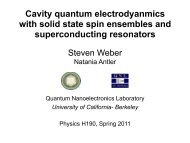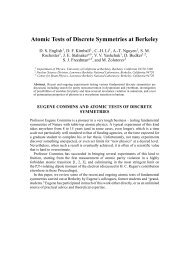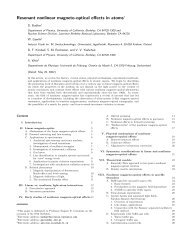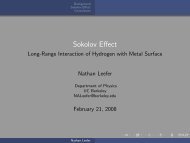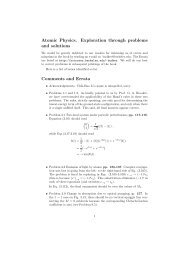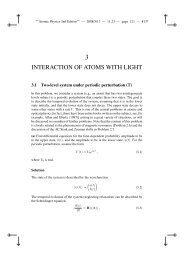Nonlinear magneto-optical rotation in optically thick media
Nonlinear magneto-optical rotation in optically thick media
Nonlinear magneto-optical rotation in optically thick media
Create successful ePaper yourself
Turn your PDF publications into a flip-book with our unique Google optimized e-Paper software.
spontaneous decay rate from the upper state, and ξ representsthe quantum number dist<strong>in</strong>guish<strong>in</strong>g the groundstate (ξ g ) from the excited state (ξ e ). Λ = Λ 0 + Λ repop isthe pump<strong>in</strong>g term, where the diagonal matrixdescribes <strong>in</strong>coherent ground state pump<strong>in</strong>g (ρ 0atomic density), and2is the〈ξ g J g m|Λ 0 |ξ g J g m〉 =γρ 0(2J g + 1)(3)〈ξ g J g m|Λ repop |ξ g J g m ′ 〉 = γ 0∑m e,m ′ e ,q 〈J g , m, 1, q|J e , m e 〉〈J g , m ′ , 1, q|J e , m ′ e 〉ρ ξ eJ em eξ eJ em ′ e , (4)describes repopulation due to spontaneous relaxationfrom the upper level (see, e.g., Ref. [15]). Here 〈. . .| . . .〉are the Clebsch-Gordan coefficients.The electric field vector is written (see, e.g., Ref. [16])⃗E = 1 []E 0 e iφ (cos ϕ cos ɛ − i s<strong>in</strong> ϕ s<strong>in</strong> ɛ)e i(ωt−kz) + c.c. ˆx2+ 1 []E 0 e iφ (s<strong>in</strong> ϕ cos ɛ + i cos ϕ s<strong>in</strong> ɛ)e i(ωt−kz) + c.c. ŷ,2(5)where ω is the light frequency, k = ω/c is the vacuumwave number, E 0 is the electric field amplitude, ϕ is thepolarization angle, ɛ is the ellipticity (arctangent of theratio of the major and m<strong>in</strong>or axes of the polarizationellipse), and φ is the overall phase. By substitut<strong>in</strong>g (5)<strong>in</strong>to the wave equation( ) ω2c 2 + d2 ⃗Edz 2 = − 4π d 2c 2 dt ⃗ 2 P, (6)where ⃗ P = T r(ρ ⃗ d) is the polarization of the medium, theabsorption, <strong>rotation</strong>, phase shift, and change of ellipticityper unit distance for an <strong>optical</strong>ly th<strong>in</strong> medium canbe found <strong>in</strong> terms of the density matrix elements (theseexpressions are given <strong>in</strong> Ref. [17]). Once the solutionsfor the density matrix are obta<strong>in</strong>ed, we will perform an<strong>in</strong>tegration to generalize the result to <strong>media</strong> of arbitrary<strong>thick</strong>ness.III.THE DOPPLER-FREE CASEWe consider the case of a J = 1 → J = 0 transition,and l<strong>in</strong>early-polarized <strong>in</strong>cident light, with a magneticfield directed along the light propagation direction(Faraday geometry). Us<strong>in</strong>g the rotat<strong>in</strong>g wave approximation,the solution of Eq. (1) is obta<strong>in</strong>ed, and from this,analytic expressions for th<strong>in</strong> medium absorption and <strong>rotation</strong>are found. These expressions can be simplified byassum<strong>in</strong>g that γ ≪ γ 0 . We first consider the case wherethe power-broadened l<strong>in</strong>e width is much greater than theDoppler width. In this case, the absorption coefficientper unit length α is found to beα ≈α 0(2∆/γ 0 ) 2 + 2κ/3 + 1 , (7)where ∆ is the light-frequency detun<strong>in</strong>g from resonance,κ = d2 E 2 0¯h 2 γγ 0(8)is the <strong>optical</strong> pump<strong>in</strong>g saturation parameter, andα 0 ≈ 16π λ2 n (9)is the unsaturated absorption coefficient on resonance,where λ is the transition wavelength and n is the atomicdensity. For Ω ≪ γ, where Ω = gµB is the Larmorfrequency (g is the Landé factor, and µ is the Bohr<strong>magneto</strong>n), the slope of <strong>optical</strong> <strong>rotation</strong> per unit length,dϕ/(dΩdx), (proportional to <strong>rotation</strong> for small magneticfields) is found to bedϕdΩdx ≈ 1 α 0γ (2∆/γ 0 ) 2 + 2κ/3 , (10)where we have neglected l<strong>in</strong>ear <strong>optical</strong> <strong>rotation</strong>. Ingeneral, <strong>optical</strong> <strong>rotation</strong> can be <strong>in</strong>duced by either l<strong>in</strong>eardichroism or circular birefr<strong>in</strong>gence. Analysis of thesteady-state polarization of the ground state shows thatboth processes contribute here: the contribution due tol<strong>in</strong>ear dichroism <strong>in</strong>duced <strong>in</strong> the medium is given bydϕdΩdx∣ ≈ 1 1α 0dichr.γ 1 + (2∆/γ 0 ) 2 (2∆/γ 0 ) 2 + 2κ/3 , (11)and the contribution due to circular birefr<strong>in</strong>gence (aris<strong>in</strong>gdue to alignment-to-orientation conversion <strong>in</strong> the presenceof both the magnetic field and the strong electricfield of the light [13]) is given bydϕdΩdx∣ ≈ 1 (2∆/γ 0 ) 2 α 0biref.γ 1 + (2∆/γ 0 ) 2 (2∆/γ 0 ) 2 + 2κ/3 . (12)


